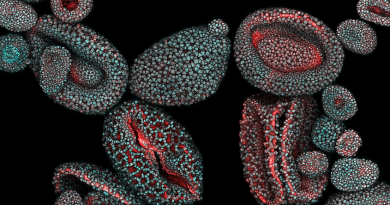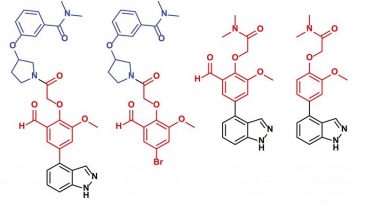Baylor College of Medicine recognizes research excellence with DeBakey Awards
Six Baylor College of Medicine faculty members were selected as recipients of the 2023 Michael E. DeBakey Excellence in Research Award. They were honored at a ceremony at Baylor Sept. 18, where they each presented a talk about the work for which they were recognized.

The 2023 Michael E. DeBakey Excellence in Research Award winners are Dr. Olivier Lichtarge, Dr. Daisuke Nakada, Dr. Fritz Sedlazeck, Dr. Jeffrey Rogers, Dr. François St-Pierre and Dr. Yong Xu.
“We are very proud of our six award winners who are being recognized for their important work and significant publications over a three-year period,” said Baylor President, CEO and Executive Dean Dr. Paul Klotman. “It is appropriate that this award is named for Dr. Michael DeBakey. Not only was he Baylor College of Medicine’s first president but he also was an accomplished innovator and researcher.”
Baylor Vice President of Research Dr. Mary Dickinson recognized and thanked the DeBakey Medical Foundation for its support of the award, and introduced and presented the award to each recipient.

Olivier Lichtarge, M.D., Ph.D.
Cullen Chair and Professor in the Department of Molecular and Human Genetics and in Biochemistry and Molecular Biology.
Lichtarge’s research combines computer analyses with experiments to understand the molecular evolution of genes and pathways — how their functions may be altered by genetic mistakes or how they may be reengineered to new designs. Using this innovative approach, he has identified genes and molecular pathways linked to autism, cancer and Alzheimer’s disease.
Lichtarge uses a mathematical equation that quantifies the evolutionary action of mutations on fitness to bridge molecular biology and population genetics. In his studies on autism spectrum disorders (ASD), this approach revealed characteristic differences in genes and processes linked to nerve transmission and neurodevelopment, shedding light on the molecular mechanisms of ASD. A key result was that the predicted fitness impact of variants correlated with the IQ of individuals with the conditions.
His work in cancer identified 460 genes undergoing selection in tumors. Some, not previously known, were then validated experimentally, providing an improved understanding in cancer biology. In his study of Alzheimer’s disease, he combines evolutionary calculations with machine learning. This approach uncovered immune response genes and showed that analyses of ever smaller patient cohorts still could robustly identify relevant genes.
Collectively, Lichtarge’s studies establish this new calculus of evolutionary fitness as a fundamental tool to discover disease mechanisms and inform precision medicine. His work unifies elementary concepts from mathematics, physics and evolution into a single, coherent and powerfully predictive model of life.

Daisuke Nakada, Ph.D.
Professor in the Department of Molecular and Human Genetics and member of the Dan L Duncan Comprehensive Cancer Center
Nakada’s research focuses on the molecular and cellular mechanisms that regulate the biology of hematopoietic stem cells (HSCs) (the parent cells of blood cells) and leukemia, cancers of blood-forming cells. He’s particularly interested in understanding how HSCs are maintained throughout life, the mechanisms that transform normal HSCs into cells that give rise to acute myeloid leukemia (AML) and identifying vulnerabilities in these cancerous cells to improve AML treatment.
Regarding the biology of HSC, his lab discovered that estrogen, the female sex hormone, promotes the proliferation of HSCs, providing a novel conceptual framework to investigate blood disorders that have sex differences, such as blood cancers and autoimmune diseases.
Nakada’s work also established that AML cells highjack some of the cells’ metabolic pathways, turning these pathways into vulnerabilities that could guide the development of novel therapies. For example, Nakada found that while healthy HSCs do not depend on the metabolic pathway AMPK, the pathway is critical for AML cells, suggesting that therapies directed at AMPK could help control AML. Nakada also showed that AML cells depend on selenium, a chemical element that is essential for cells in trace amounts, and that this dependency can be targeted by restricting selenium in the diet.
These studies were facilitated by Nakada’s development of an efficient method to edit the genomes of HSCs. This method was used to develop new mouse models of hematological malignancies and to investigate the genetic interactions in both mouse and human AML models, setting the research conducted by the Nakada lab at the forefront of HSC leukemia stem cell biology.

Fritz Sedlazeck, Ph.D.
Associate Professor in the Department of Molecular and Human Genetics and the Human Genome Sequencing Center
Sedlazeck’s research focuses on the understanding of genome instability and complex variations and their impact on evolution and disease. His team spearheaded the detection of structural variations using long read sequencing data. This research has significantly advanced the understanding of complex cardiovascular, neurological and Mendelian diseases, uncovering crucial insights into their underlying genetic mechanisms and potential avenues for diagnosis and treatment. He remains at the forefront of research on clinically significant genes within complex regions of the human genome, often referred to as “dark” regions.
He played an instrumental role in the completion of sequencing the remaining sections of the human genome, with his groundbreaking findings published in Science last year. He has made significant contributions to clinical diagnostics by collaborating with Stanford Clinic and Google Health to improve the accuracy of clinical sequencing and reduce the time it takes from weeks to just eight hours.
For the past five years, he has organized an annual hackathon where people from around the world meet and work together on computational prototypes to obtain deeper insights into open genomics and biomedical research questions. This event brings together a diverse group of approximately 90 individuals each year from all continents, including students and faculty members, fostering a collaborative spirit that enriches the field of computational biology. Sedlazeck also is an adjunct associate professor of computer science at Rice University.

Jeffrey Rogers, Ph.D.
Associate Professor in the Department of Molecular and Human Genetics and the Human Genome Sequencing Center
Rogers is an internationally recognized expert in the genetics and genomics of nonhuman primates. One area of his research focuses on the discovery and characterization of genetic variation within nonhuman primate species that are used as models of human disease. These efforts have identified several novel and significant spontaneous genetic models of human clinical disorders, including retinal disease, endometriosis, colorectal cancer and anxiety disorders. His second line of research is the development of new fundamental information regarding primate genomics, including but not limited to production of whole genome reference assemblies, quantitative analysis of genetic diversity within and among wild populations of nonhuman primates, the analysis of inter-species hybridization and studies of mechanisms of primate speciation.
Rogers serves as one of three co-leaders of the Primate Conservation and Sequencing Consortium, an international collaboration involving primatologists, geneticists, bioinformaticians and evolutionary biologists. He and his co-leaders supervised the whole genome sequencing of nonhuman primates from 233 distinct species, the largest dataset of primate genomic information published to date. The data revealed new insights into primate evolution, biodiversity conservation and genetic causes of human disease, and the findings were published in a series of five articles in a special issue of Science this year.

François St-Pierre, Ph.D.
Assistant Professor in the Department of Neuroscience and a McNair Scholar, Adjunct Professor, Electrical and Computer Engineering, Rice University
St-Pierre’s lab develops new tools and methods to accelerate neuroscience research. He does this through the engineering of fluorescent indicators of neural activity, optogenetic tools to silence neurons, synthetic gene circuits and novel methods for high-throughput screening.
Three recent publications show the depth and breadth of his research program and how he works in a novel and creative way to overcome difficulties in advancing neuroscience research.
His paper on synthetic neurobiology in Nature Communications shows how he is overcoming a major challenge in heterologous expression studies in that different cells will be transfected/transduced with varying numbers of plasmids/vector particles, resulting in overexpression and underexpression of the protein of interest. To remedy this problem, he and his team have engineered and published a transcriptional circuit called the Equalizer that buffers this variation in copy number. They are now further developing their Equalizer system for the controlled expression of indicators and actuators in vivo.
The second paper in Science Advances on accelerating protein engineering addresses a major problem that St-Pierre overcame to perform high throughput screening of novel genetically encoded indicator and reporter proteins. Genetic indicator development remains long and tedious given the limited size of libraries that can be screened with current technologies. To accelerate engineering, St-Pierre’s group has developed and published a novel optical platform (SPOTlight) that can screen up to a million variations per round, several orders of magnitude larger than current libraries. They are applying this platform to various projects in the lab while continuously improving the underlying technology.
Finally, in Cell, St-Pierre describes the development and employment of a revolutionary genetically encoded voltage-sensor that works optimally under two-photon illumination to track neuronal voltage changes in neuron and other cells in vivo. Transmembrane voltage is a critical information carrier in the brain: neurons communicate and process information by regulating their membrane voltage, and aberrant neuronal voltage dynamics are implicated in many neurological disorders.
Tools to record voltage signals are thus fundamental to studying how the brain functions in health and disease. St-Pierre’s lab focuses on evolving Genetically Encoded Voltage Indicators, fluorescent proteins whose brightness is modulated by voltage, as they promise to detect voltage dynamics in specific cell types over long time scales, deep in the brain and with millisecond timescale and micron-scale spatial resolution. They show in this paper that their recently developed voltage indicator enables sustained, deep optical recording of fast voltage dynamics in awake behaving mice.

Yong Xu, M.D., Ph.D.
Professor in the Department of Pediatrics – Nutrition, Associate Director for Basic Sciences, Children’s Nutrition Research Center at Baylor College of Medicine and Texas Children’s Hospital
Yong Xu’s research program focuses on central mechanisms for the regulations of feeding behavior and body weight. Using cutting-edge modern neuroscience technology, Xu has identified novel hypothalamic circuits, neural messengers and intracellular molecules critical for the regulation of feeding behavior and body weight. His discoveries are highly relevant to common human diseases, especially obesity, diabetes and eating disorders.
Recently, Xu and his collaborators identified a novel mechanism for human obesity that will guide better diagnosis and treatment for a subset of individuals with obesity. Many genetic variants in humans that affect weight are enriched in the brain, implicating neural dysfunctions in the susceptibility to obesity. Xu teamed up with physician-scientists to combine human genetics and basic animal neuroendocrinology by using the human/mouse genetic approach to identify HTR2C (encoding serotonin 2C receptor) mutations as the cause of human obesity. These findings indicate that the HTR2C gene should be included in the genetic screening panel for human obesity. In addition, Xu revealed that the impaired melanocortin signaling in the brain contributes to overeating and weight gain caused by the HTR2C mutations, and therefore suggest that patients with HTR2C deficiency can be treated by an FDA-approved melanocortin agonist, also known as setmelanotide.
Xu has also revealed a potential pathophysiologic basis for anorexia nervosa and provided a mechanistic framework for developing novel therapeutic strategies for this disease. Xu showed that dopamine (DA) neurons bidirectionally regulate the activity of midbrain 5-HT neurons, with weaker stimulation causing dopamine receptor D2 (DRD2)-dependent inhibition and overeating, and stronger stimulation causing dopamine receptor D1 (DRD1)-dependent activation and anorexia. In a mouse model for anorexia nervosa, DA actions on 5-HT neurons shift from a DRD2-mediated neurotransmission to a DRD1-mediated process, which causes constant activation of 5-HT neurons, resulting in anorexia.
These results revealed an interesting DA to 5-HT neurocircuit whose neurotransmission and behavioral outcome are bidirectional, depending on the strength of DA inputs. The findings indicate that an enhanced DRD2 neurotransmission onto 5-HT neurons contributes to the development of anorexia nervosa, and further demonstrate the therapeutic potential of DRD1 antagonists in this devastating and life-threatening disease.
In addition, Xu identified a novel exercise-induced metabolite that reduces food intake and improves glucose balance, which paved the way to develop exercise mimetics as effective anti-obesity and anti-diabetic medicines. Xu and the team showed that exercise stimulates production of Lac-Phe, a blood-borne signaling metabolite. In diet-induced obese mice, Lac-Phe reduces food intake without affecting movement or energy expenditure. Chronic treatment with Lac-Phe decreases adiposity and body weight and improves glucose homeostasis. Conversely, genetic ablation of Lac-Phe biosynthesis in mice increases their food intake and leads to obesity. This data defines a conserved exercise-inducible metabolite that controls food intake and influences systemic energy balance and resulted in a patent for this metabolite.
By Dana Benson
Follow From the Labs on Twitter @BCMFromtheLabs.



